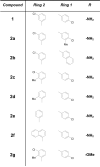Rational modification of a candidate cancer drug for use against Chagas disease
- PMID: 19239254
- PMCID: PMC2715367
- DOI: 10.1021/jm801313t
Rational modification of a candidate cancer drug for use against Chagas disease
Erratum in
- J Med Chem. 2009 Aug 13;52(15):4979
- J Med Chem. 2009 Jul 23;52(14):4549
Abstract
Chagas disease is one of the major neglected diseases of the world. Existing drug therapies are limited, ineffective, and highly toxic. We describe a novel strategy of drug discovery of adapting an existing clinical compound with excellent pharmaceutical properties to target a pathogenic organism. The protein farnesyltransferase (PFT) inhibitor tipifarnib, now in phase III anticancer clinical trials, was previously found to kill Trypanosoma cruzi by blocking sterol 14 alpha-demethylase (14DM). We rationally developed tipifarnib analogues that display reduced affinity for human PFT to reduce toxicity while increasing affinity for parasite 14DM. The lead compound has picomolar activity against cultured T. cruzi and is efficacious in a mouse model of acute Chagas disease.
Figures









Similar articles
-
Second generation analogues of the cancer drug clinical candidate tipifarnib for anti-Chagas disease drug discovery.J Med Chem. 2010 May 27;53(10):3887-98. doi: 10.1021/jm9013136. J Med Chem. 2010. PMID: 20429511 Free PMC article.
-
The protein farnesyltransferase inhibitor Tipifarnib as a new lead for the development of drugs against Chagas disease.J Med Chem. 2005 Aug 25;48(17):5415-8. doi: 10.1021/jm050441z. J Med Chem. 2005. PMID: 16107140 Free PMC article.
-
Pharmacological characterization, structural studies, and in vivo activities of anti-Chagas disease lead compounds derived from tipifarnib.Antimicrob Agents Chemother. 2012 Sep;56(9):4914-21. doi: 10.1128/AAC.06244-11. Epub 2012 Jul 9. Antimicrob Agents Chemother. 2012. PMID: 22777048 Free PMC article.
-
[The chemotherapy of Chagas disease].Medicina (B Aires). 1999;59 Suppl 2:147-65. Medicina (B Aires). 1999. PMID: 10668258 Review. Spanish.
-
Chemotherapy of Chagas disease.Curr Pharm Des. 2002;8(4):287-95. doi: 10.2174/1381612023396177. Curr Pharm Des. 2002. PMID: 11860367 Review.
Cited by
-
Chemical-biological characterization of a cruzain inhibitor reveals a second target and a mammalian off-target.Beilstein J Org Chem. 2013;9:15-25. doi: 10.3762/bjoc.9.3. Epub 2013 Jan 4. Beilstein J Org Chem. 2013. PMID: 23400640 Free PMC article.
-
Synthetic Medicinal Chemistry in Chagas' Disease: Compounds at The Final Stage of "Hit-To-Lead" Phase.Pharmaceuticals (Basel). 2010 Mar 25;3(4):810-838. doi: 10.3390/ph3040810. Pharmaceuticals (Basel). 2010. PMID: 27713281 Free PMC article. Review.
-
Protein Lipidation: Occurrence, Mechanisms, Biological Functions, and Enabling Technologies.Chem Rev. 2018 Feb 14;118(3):919-988. doi: 10.1021/acs.chemrev.6b00750. Epub 2018 Jan 2. Chem Rev. 2018. PMID: 29292991 Free PMC article.
-
Sterol 14alpha-demethylase (CYP51) as a therapeutic target for human trypanosomiasis and leishmaniasis.Curr Top Med Chem. 2011;11(16):2060-71. doi: 10.2174/156802611796575902. Curr Top Med Chem. 2011. PMID: 21619513 Free PMC article. Review.
-
Drug strategies targeting CYP51 in neglected tropical diseases.Chem Rev. 2014 Nov 26;114(22):11242-71. doi: 10.1021/cr5003134. Epub 2014 Oct 22. Chem Rev. 2014. PMID: 25337991 Free PMC article. Review. No abstract available.
References
-
- Sparreboom A, Marsh S, Mathijssen RH, Verweij J, McLeod HL. Pharmacogenetics of tipifarnib (R115777) transport and metabolism in cancer patients. Investigational New Drugs. 2004;22:285–9. - PubMed
-
- Zujewski J, Horak ID, Bol CJ, Woestenborghs R, Bowden C, End DW, Piotrovsky VK, Chiao J, Belly RT, Todd A, Kopp WC, Kohler DR, Chow C, Noone M, Hakim FT, Larkin G, Gress RE, Nussenblatt RB, Kremer AB, Cowan KH. Phase I and pharmacokinetic study of farnesyl protein transferase inhibitor R115777 in advanced cancer. Jounal of Clinical Oncology. 2000;18:927–941. - PubMed
-
- Venet M, End D, Angibaud P. Farnesyl protein transferase inhibitor ZARNESTRA R115777 - history of a discovery. Current Topics in Medicinal Chemistry. 2003:3. - PubMed
-
- Molina J, Martins-Filho O, Brener Z, Romanha AJ, Loebenberg D, Urbina JA. Activities of the Triazole Derivative SCH 56592 (Posaconazole) against Drug-Resistant Strains of the Protozoan Parasite Trypanosoma (Schizotrypanum) cruzi in Immunocompetent and Immunosuppressed Murine Hosts. Antimicrobial Agents and Chemotherapy. 2000;44:150–5. - PMC - PubMed
Publication types
MeSH terms
Substances
Grants and funding
LinkOut - more resources
Full Text Sources
Other Literature Sources
Chemical Information
Medical

